Design Broadband Network with mpls, segment-routing, evpn, multicast mvpn
27.03 2024 | by massimilianoBroadband Network Area: hardware devices and example network design max-level of High-Availability to make sure toward a Broadcast level for […]
Broadband Network Area: hardware devices and example network design
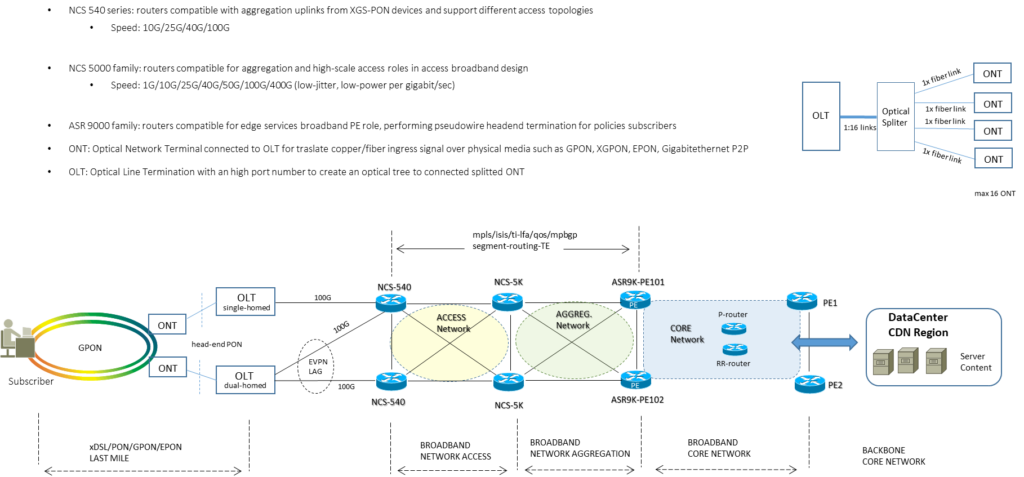
max-level of High-Availability to make sure toward a Broadcast level for streaming services


SRTE Policy identification
- Headend: where the policy is initialized
- Color: a numeric value to differentiate multiple SRTE policies between the same couple of router
- End-Point: where the policy finish (destination policy)
Example config:
policy <name_policy>
Color <number_color> end-point ipv4 <ip_address>

SRTE Policy Candidate Path
- SR policy consist of one to more possible path called CPATH (Candidate Path)
- Candidate Path could be dynamic or explicit
- Candidate Path is a single segment-list or a set of SID-list weighed
Dynamic Path
- Dynamic path is the creation of path obtained through a set of contrainst = Optimization Objective
- Headend node compute the best-path basing on segment list information or through a set of SID List
- It is possible to delegate the computation of information via external controller called PCE (Path Computation Element) when we are in a multidomain network
- SR-Native algorithm has been deployed to computing path basing on ECMP (this provide the possibility to have load-sharing over multiple links)

MPLS Segment-Routing and TI-LFA example config

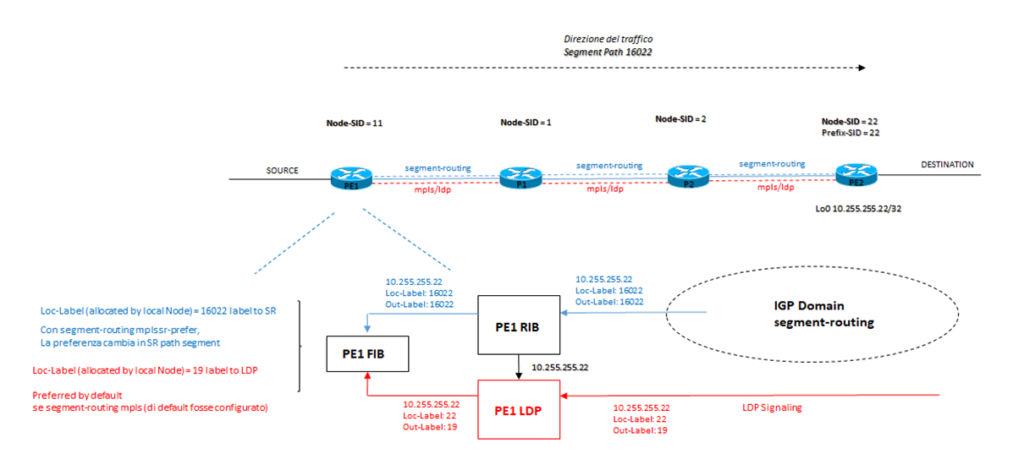
VLAN Architecture scenario with three ways
- VLAN per-Service (N:1 VL)
- VLAN per-Subscriber (1:1 VL)
- MVLAN per-Customer (hybrid combination to carry unicast traffic plus one shared multicast vlan dedicated to Video Content)
In 1:1 VL scenario each subscriber is mapped with own vlan
In N:1 VL scenario is deployed using QinQ double tagging (C-VL + S-VL) to overcome the limit of 4096 vlans
OLT in multi-homed scenario resolve the possible single-point of failure node via EVPN tecnologies;
EVPN support active-active redundant link (bundle-ethernet)

EVPN Tecnology
EVPN work with Element Segment Identifier (ESI) or whole of ES in a multihomed connection PE-CE
- ES = 0 –> mean a single-homed connection
- ES = null –> mean a multi-homed connection
EVI = EVPN instance virtual identifier: simil to VRF L3VPN and for each EVI is associated a route-target import/export
EVI could be mapped with a Bridge Domain for packets toward the Core Network MPLS
- RT-1: Ethernet Auto Discovery advertised per-EVI instance or per-ESI (ethernet segment identifier); transport a EVI list belonging to a ES (ethernet segment);
- RT-2: MAC/IP advertisement Route used per-vlan base to all PE node belonging at one EVI that join to it. The IP are base-host-route and mac address are advertised to peer via NLRI;
- RT-3: Inclusive Multicast Ethernet Tag Route (used to BUM traffic between PE nodes source and destination and advertised per-vlan base and per-ESI base;
- RT-4: Ethernet Segment Route enabled the discovery PE connected at same ethernet-segment
- RT-5: IP Prefix Route used to subnet prefix (example an /24 subnet)
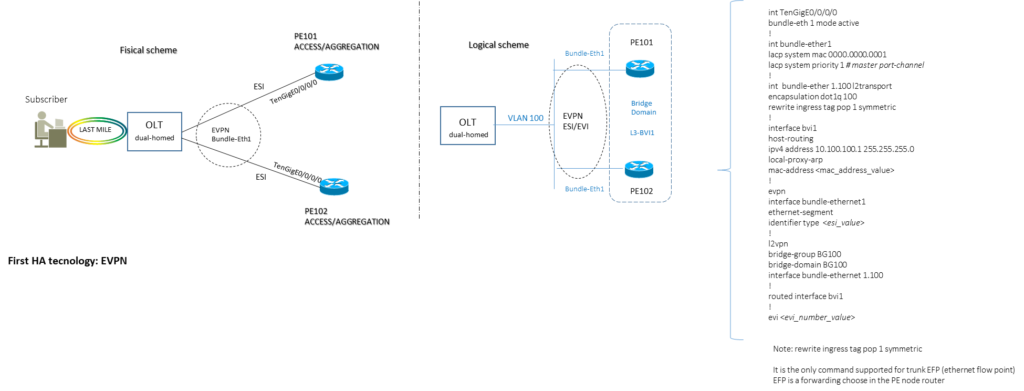
Pseudowire Full Mesh Topology = VPLS
Pseudowire start on PE101 and PE102 and ended to router PE (headend)
When the first DHCP request from the subscriber came on the pseudowire headend, BNG will autenticate the source mac-address and apply per-subscriber policy
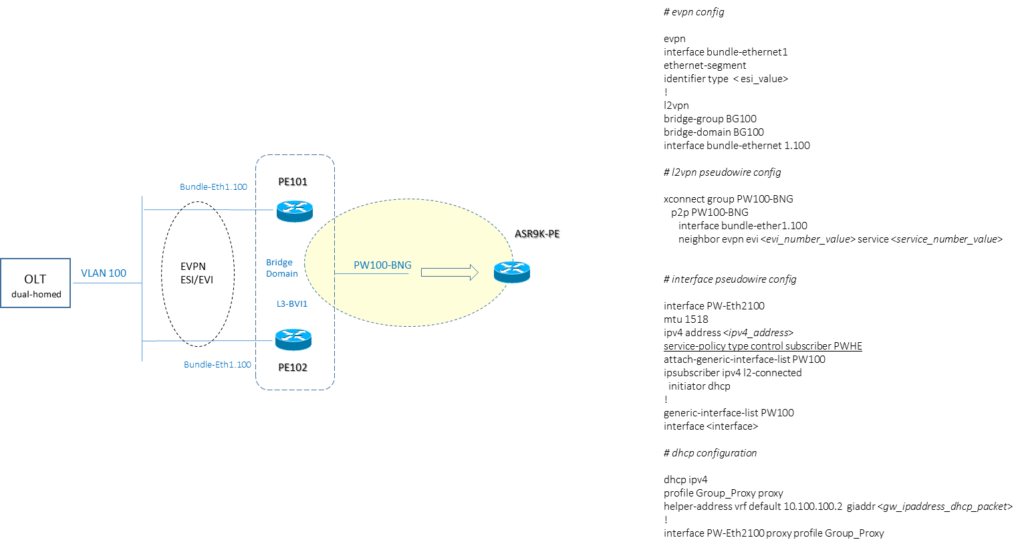
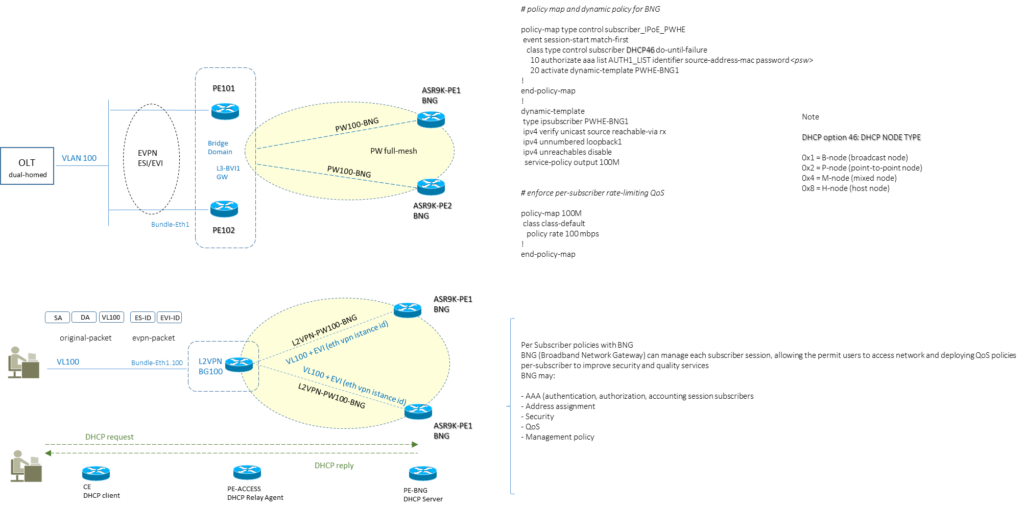
MPBGP to send address-family L2VPN

Tunnel Multicast Next-Generation MVPNs
- MI-PMSI = Multicast Inclusive = all to all = mp2mp = all node PE can forward MVPN multicast packets domain to all PE router
- UI-PMSI = Unidirectional Inclusive = some to all = p2mp = selected PE can forward MVPN multicast packet domain to all PE router
- S-PMSI = Selective = some to some = selected PE router can forward MVPN packets domain to only selecter PE router
| ROUTE TYPE (CONTROL-PLANE) | DESCRIPTION |
| Type-1 Intra-AS I-PSMI AD | Originated by all PE routers and used for advertising and learning intra-AS MVPN membership information |
| Type-2 Inter-AS I-PMSI AD | Originated by ASBR-MVPN routers and used for advertising and learning inter-AS MVPN membership information |
| Type-3 S-PMSI AD | Originated by Ingress PE routers and used for initiating a selective P-tunnel for a given C-Source and C-Group multicast stream |
| Type-4 Leaf AD | Originated by Egress PE routers in responce to a Type-3 advertisment; it is used for indicating interest for a given C-Source and C-Group multicast stream |
| Type-5 Source Active AD | Originated by a Ingress PE routers when it learns about an active multicast Source; the Type-5 is advertised to all Egress PE routers that belongs to a given MVPN |
| Type-6 Shared Tree Join | Originated by an Egress PE routers when it receive a PIM Shared Tree Join ( C – *, C-G) from the CE device |
| Type-7 Source Tree Join | Originated by an Egress PE routers when it receive a Source Tree Join or when it receive a Type-5 route announcement from an Ingress PE router |
- Ingress PE router refer to a PE node that has an active C-MCAST source for a given MVPN
- Egress PE router refer to a Leaf nodes

| BGP TYPE | DESCRIPTION |
| BGP Type-1 AD routes | Every MVPN PE routes advertise a BGP type-1 route for each MVPN hosted If a PE router is connected to three MVPN customers site, then the total of three BGP type-1 routes are created and advertised to every MVPN PE in the network |
| BGP Type-3 and Type-4 S-PMSI routes | An Ingress PE router signal a type-3 BGP route for the creation of S-PMSI; Egress PE router, upon receipt the type-3 bgp route, with interested receivers will respond to the announcement by advertising a type-4 route. After this step, an Ingress PE router creates the right P-tunnel |
| BGP Type-5 Source Active routes | BGP Type-5 carry information about active VPN source and the group to which they are trasmitting data; this route are generated by any PE router that becomes aware of an active source. Type-5 routes apply only for PIM-SM ASM (Any Source Multicast) when the inter-site source-tree-only mode is used |
| BGP Type-6 and Type-7 routes | C-multicast route exchange between PE router refers to the propagation of C-Joins from Receiver PEs node to the sender Pes Into a MVPN domain, C-Joins are translated (encoded) into BGP C-multicast MVPN routes and advertised via a BGP MCAST-VPN address family toward the sender PEs |
| BGP Type-6 C-multicast routes | are used for information contained in a Shared Tree (C-*, C-G) join |
| BGP Type-7 C-multicast routes | are used for information contained in a Source Tree (C-S, C-G) join |
| TUNNEL TYPE (DATA-PLANE) | DESCRIPTION |
| Tunnel Type-0 | No Tunnel Information is present |
| Tunnel Type-1 | RSVP-TE with Point-to-Point LSP |
| Tunnel Type-2 | MLDP with Point-to-Multipoint LSP |
| Tunnel Type-3 | PIM-SSM (Source Specific Multicast) |
| Tunnel Type-4 | PIM-SM (Sparse-Mode Tree) |
| Tunnel Type-5 | PIM Bidir (Bidirectional Tree) |
| Tunnel Type-6 | Ingress Replication (the capacity to forwarding multiple multicast MVPN traffic from one IngressPE to all Egress-PE) |
| Tunnel Type-7 | MLDP MP2MLSP |
